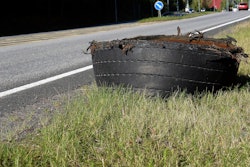
“Baby it’s cold outside.” Many of us have heard that song, and those of us who reside, or have resided, in the northern parts of the U.S. can relate.
Trust me when I say your tires also can relate, too. In short, cold air has a major impact on them as well. We can bundle up to beat the cold, but the tire needs something different: proper air pressure.
We know that as a tire runs it heats up, coupled with ambient temperatures creates increases of air pressure inside the tire chamber. This phenomenon applies to the cold as well, except in the reverse.
The chart gives examples of the effect that ambient temperatures can have on the air pressure inside the tire chamber.
 This chart is approximate and does not take into consideration of the heat generated when the tire is in operation.
This chart is approximate and does not take into consideration of the heat generated when the tire is in operation.
Check and adjust the air pressure indoors when the equipment is not cold (outside temp). Doing this gives you the best baseline, ensuring proper pressure for the capacity required.
Ensure your air delivery supply has air driers and that they are functional. Use of nitrogen is also an advantage.
Tire maintenance is a vital part of any fleets program and has a large impact on their bottom line. Considering mileage, rolling resistance, and durability, proper air pressure has an overwhelming impact on each of these. Whether hot, cold, or just right, temperature and air pressure remain a tires best friend or worst enemy.
What effects can temperature and resulting changes in the air pressure potential have on a tire?
Underinflated
- Reduced fuel efficiencies
- Increased outside (shoulder) wear.
- Increased risk of sudden loss of air (blowout)
Overinflated
- Reduced traction, (not allowing the radial tire to flex as designed).
- Increased center tread wear
- Harsher ride
Use of proper valve caps and procedures are also things to consider. We all know that anything below 32 degrees will freeze water. We also know that when water freezes, the ice expands. When checking air pressures in the cold there are a couple things to take into consideration when possible.
Use metal non-pass-through valve caps. Pass through caps can collect moisture from the tire chamber or from the air supply. When this cap is introduced to the colder ambient air it can freeze and expand, potentially releasing air. Solid metal caps can assist in preventing this.










